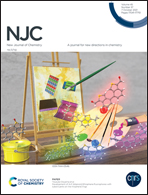Co-embedded sulfur vacant MoS2 monolayer as a promising catalyst for formaldehyde oxidation: a theoretical evaluation†
Abstract
In this work, we theoretically evaluated the complete catalytic oxidation of formaldehyde (HCHO) catalyzed by a cobalt embedded sulfur vacant MoS2 (COSv–MoS2) monolayer. The density functional theory calculations demonstrate that the Co atom is strongly anchored at the S vacancy site of the MoS2 monolayer forming a single-atom catalyst without metal clustering. From the study of all possible elementary steps, we propose two possible catalytic pathways for HCHO oxidation; (1) consecutive path: HCHO dehydrogenation followed by CO oxidation with O2, and (2) co-adsorption path: HCHO oxidation by O2 through the Langmuir–Hinshelwood mechanism. Compared to the catalysts reported in the literature, this catalyst presents lower activation energy barriers for C–H bond cleavage. At room temperature, the consecutive path is found to be dominant, and the calculated activation free energy barrier is only 0.46 eV (44.38 kJ mol−1). Our kinetic analyses show that HCHO oxidation can easily occur at room temperature with a rate of 1.12 × 105 s−1. Therefore, this non-noble metal single atom COSv–MoS2 catalyst demonstrates excellent activity for HCHO catalytic oxidation at low temperatures.



 Please wait while we load your content...
Please wait while we load your content...